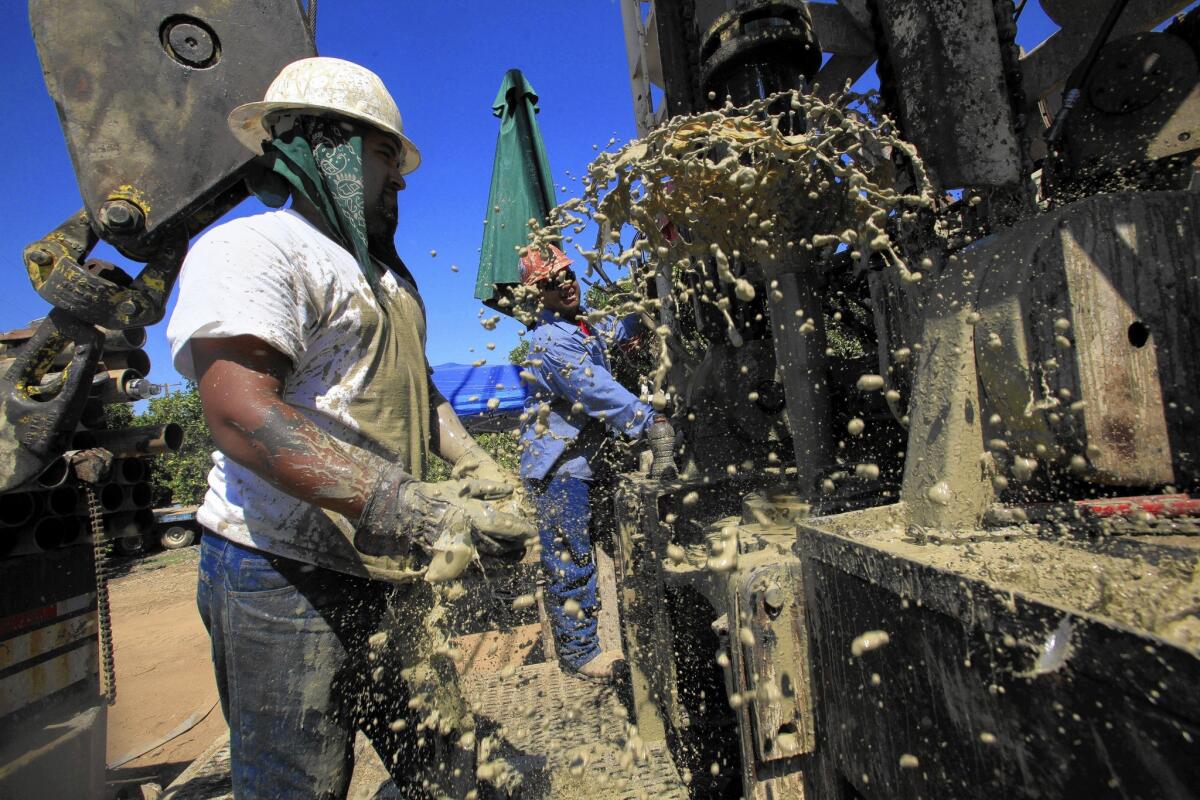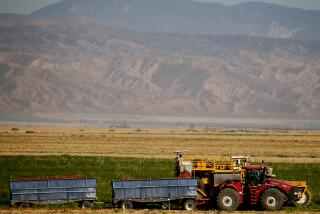Farmers drilling deeper for water as drought drags on

Reporting from TERRA BELLA, Calif. — On a dusty clearing between a fallow wheat field and wilting orange groves, Steve Arthur’s crew of two mud-splattered well drillers worked furiously to deliver a lifeline to another despondent farmer.
Using a diesel-powered rig that rumbled like a moving subway car, the workers bore deeper and deeper into the packed clay in hopes of tapping a steady supply of groundwater — about the only source of water that remains for many growers in this parched rural community about 40 miles north of Bakersfield.
Only a lucky few get a visit from Arthur. His waiting list, recorded in two 4-inch-thick binders, would take a year to clear. Most farmers can’t wait that long to save their fields. Arthur has declined cash offers from growers to jump ahead in line.
“Many of these farmers tell me they’d hate to be in my shoes,” said Arthur, 54, a second-generation driller. “What do you tell someone who is losing their crop?”
California’s three-year drought has sparked a surge in demand for wells in the state’s agricultural heartland. With federal and state allocations of surface water reduced to a trickle, growers are searching deeper underground for sources of water to keep their farms from ruin.
The clamor has overwhelmed California drillers and pump installers, forcing some farms to hire contractors from neighboring states.
It’s also setting the stage for more problems later as groundwater supplies are shrinking faster than they can be replenished. In parts of the Central Valley, the water table has plummeted, drying up old wells and sinking the land above, a phenomenon called subsidence.
That’s resulted in even deeper wells that cost hundreds of thousands of dollars to build and require more energy to pump water to the surface. As recently as two decades ago, a well several hundred feet would suffice. Today, large farms are drilling to depths of 2,000 feet in anticipation of falling water levels.
“We’re going bigger horsepower every year,” said Charles Barber, president of Caruthers Pump south of Fresno, who has customers on a three-month waiting list. “We’ve lost 30 feet of groundwater in a year in some places. We keep that up for 10 years and we won’t be farming like this anymore.”
At the end of June, the state’s top agricultural producing county, Tulare, had issued 874 well permits, 44 more than all of last year. Fresno County, the second-biggest farm producer in California, issued 601 well permits over the same period, about 100 short of matching its total for 2013.
Without access to groundwater, an industry responsible for roughly half the nation’s fruit, nuts and vegetables would founder, according to a recent study released by the UC Davis Center for Watershed Sciences.
Well water has kept losses in California’s agricultural industry relatively modest considering the severity of the ongoing drought, the report said. The researchers estimated $1 billion in lost revenue and $500 million in additional pumping costs this year. That’s a fraction of the $40 billion the industry rings up annually.
Still, there’s little optimism the industry can weather another year relying on so much groundwater without significant consequences.
By the end of 2014 alone, groundwater is expected to replace three-quarters of the 6.6 million acre-feet of surface water lost to drought this year — raising groundwater’s share of the state’s agricultural water supply from 31% to 53%, the UC Davis report said.
“If there’s no surface water available, farmers really have no choice but to use the groundwater and use it in a very big way,” said Jay Famiglietti, a senior water scientist at the NASA Jet Propulsion Laboratory at Caltech and a professor of Earth system science at UC Irvine. “The question is how long can we keep doing this before we hit rock bottom? ... We are on a current path that is nearly the definition of unsustainable.”
In an attempt to staunch the crisis, two bills have been proposed in the California Legislature to create the state’s first groundwater management system. There are currently no restrictions on how much water a landowner can pump from beneath his or her property.
That’s given larger farms that can afford to dig deeper wells a distinct advantage over small farmers like Juan Carranza.
The Terra Bella grower farms 40 acres of navel oranges relying strictly on water from his 450-foot well. That may have been deep enough in years past, but now, after irrigating about five acres, the pump would usually start spitting air.
“Everyone around here was pumping water from their wells so the water level kept dropping,” said Carranza, 48.
There was nothing else he could do except build a deeper well. So Carranza called Arthur’s Fresno headquarters and placed an order for an 800-foot shaft, a $120,000 project. That was in November. Arthur’s crew arrived at the end of June.
“He was lucky,” Arthur said. “Our calls started doubling in March when people realized the rains weren’t coming.”
Put simply, there aren’t enough contractors and equipment in California to meet today’s unprecedented demand, said John Hofer, executive director of the California Groundwater Assn., which represents about 200 well drillers. (There are 782 active well drilling licenses in California, according to the Contractors State License Board.)
There aren’t any quick fixes either. Drilling rigs can cost $1 million and can take manufacturers months to deliver. The grueling work of managing a drill site around the clock has also discouraged many from entering the business.
“The perception is we’re getting fat off somebody else’s misery,” Hofer said. “But nobody was asking us for help three years ago. We are busy when there’s a need. And if there’s a need, it means somebody’s hurting.”
Arthur’s never been busier. He often sleeps only three to four hours a night. His cellphone rings every few minutes and his voicemail is perpetually full. At any given time, he must manage five drill sites miles apart in the Central Valley. All but one operates 24 hours a day. If he had the manpower, the fifth would too.
Arthur was 14 when he started apprenticing with his dad and uncle 40 years ago. Back then, no one could fathom having to drill several thousand feet.
“A guy would have thought you were nuts if you wanted to drill that deep,” Arthur said.
Twitter: @dhpierson
More to Read
Inside the business of entertainment
The Wide Shot brings you news, analysis and insights on everything from streaming wars to production — and what it all means for the future.
You may occasionally receive promotional content from the Los Angeles Times.











